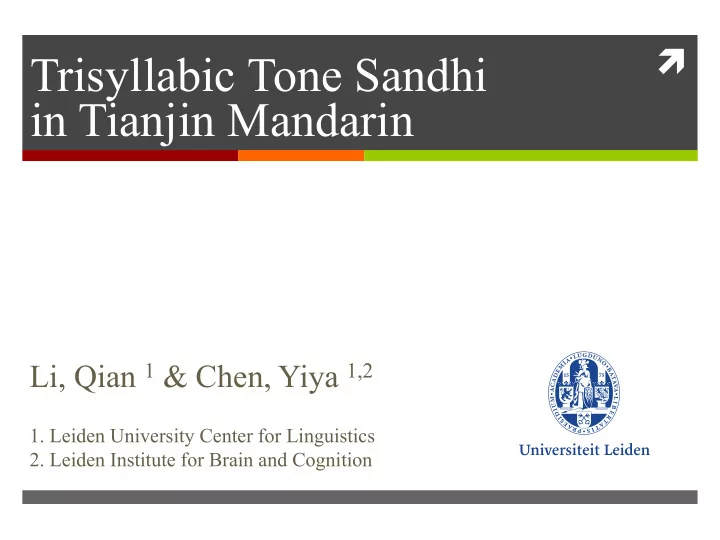

ì ¡ Trisyllabic Tone Sandhi in Tianjin Mandarin Li, Qian 1 & Chen, Yiya 1,2 1. Leiden University Center for Linguistics 2. Leiden Institute for Brain and Cognition
Mandarin speaking Non-Mandarin speaking Data from http://en.wikipedia.org/wiki/Mandarin_Chinese
Tianjin: A Different Tonal System ì Different lexical tonal contours ì More tone sandhi rules ì Complicated Tone Sandhi Application ì Hot Issues of Tianjin Tone Sandhi ¡ The exact number of bisyllabic sandhi rules ì The application of bisyllabic sandhi patterns in trisyllabic sequences ¡ ì (e.g., Zhang & Liu, 2011; Huang et al., 2005; Ma, 2005; Chen, 2000; Tan, 1987; Hung, 1987; Zhang, 1987; Li & Liu, 1985)
Lexical Tones (in isolation) Tone 1 Tone 2 Tone 3 Tone 4 Beijing High level Rising Dipping Falling Tianjin Low falling High rising Dipping High falling 20 f 0 (st) 15 10 Lower register Higher register
Tone Sandhi in Literature ì Four Claimed Bisyllabic Patterns T1+T1 → T3+T1 T3+T3 → T2+T3 T4+T4 → T1+T4 T4+T1 → T2+T1 ì 27 Claimed Trisyllabic Patterns ì 20 simple application cases e.g., T2+T1+T1 → T2+T3+T1 ì 7 complex application cases e.g., Iterative Application: T3+T1+T1 → T3+T3+T1 → T2+T3+T1 Directionality: T1+T1+T1 (e.g., Zhang & Liu, 2011; Ma, 2005; Chen, 2000; Tan, 1987; Hung, 1987; Zhang, 1987; Li & Liu, 1985; but see Huang et al., 2005 for more proposals of tone sandhi)
Research Questions ì What are the bisyllabic tone sandhi patterns in Tianjin? ì How are the bisyllabic tone sandhi patterns applied in trisyllabic sequences?
Method ì Materials 16 Bisyllabic + 64 Trisyllabic tonal combinations in Tianjin Mandarin ì Subjects 6 speakers (3 male + 3 female); in 20s ì ì Recording QUESTION: ¡ Nar 3 shi 4 yi 2 kuai 4 bu 4 mao 2 zhi 1 di 4 ? 哪儿是一块不毛之地? “Where is a barren land?” ANSWER: ¡ Sa 1 ha 1 la 1 shi 4 yi 2 kuai 4 bu 4 mao 2 zhi 1 di 4 . 撒哈拉是一块不毛之地。 “Sahara is a barren land.”
Bisyllabic Tone Sandhi – Not the change of one lexical tone to another T1+T1 → T3+T1 T3+T3 → T2+T3 20 20 T1 T3 15 15 10 5 T4+T4 → T1+T4 T4+T1 → T2+T1 25 25 High falling – T4 20 20 15 15 T4 T4 10 10 5 5 Low falling – T1 (with +/- 1 standard error of mean)
Summary of Bisyllabic Tone Sandhi ì Tone sandhi in Tianjin: Not the change of one lexical tone to another ì T3+T3 → T2+T3 – Almost neutralized with subtle differences ì T1+T1 → T3+T1 – Not neutralized ì T4+T1 → T2+T1 – Not neutralized ì T4+T4 → T1+T4 – No sandhi change
Simple Tone Sandhi Application in Trisyllabic Sequences ì Literature ì Apply consistently e.g. T1+T1+Tx Tx+T1+T1 (Huang et al., 2005; Ma, 2005; Chen, 2000; Tan, 1987; Hung, 1987; Zhang, 1987; Li & Liu, 1985) ì Our findings ì Only T3+T3 applies consistently ì T1+T1 and T4+T1 right aligned
T3+T3 → T2+T3: Consistently applied T3+T3+T1 T3+T3+T2 T3+T3+T3 T3+T3+T4 ¡ ¡ ¡ ¡ ¡ ¡ ¡ ¡ ¡ ¡ ¡ T1+T3+T3 T2+T3+T3 T3+T3+T3 T4+T3+T3 (with +/- 1 standard error of mean)
T1+T1 → T3+T1: Right aligned T1+T1+T1 T1+T1+T2 T1+T1+T3 T3+T3+T4 ¡ ¡ ¡ ¡ ¡ ¡ ¡ ¡ ¡ ¡ ¡ T1+T1+T1 T2+T1+T1 T3+T1+T1 T4+T1+T1 (with +/- 1 standard error of mean)
T4+T1 → T2+T1: Right aligned T4+T1+T1 T4+T1+T2 T4+T1+T3 T4+T1+T4 ¡ ¡ ¡ ¡ ¡ ¡ ¡ ¡ ¡ ¡ ¡ T1+T4+T1 T2+T4+T1 T3+T4+T1 T4+T4+T1 (with +/- 1 standard error of mean)
Summary of Simple Sandhi Application in Trisyllabic Sequences ì T3+T3 → T2+T3 – Consistently applied ì T1+T1 → T3+T1 – Right aligned ì T4+T1 → T2+T1 – Right aligned
Complex Sandhi Application ì 1. T3+T3+T3 Simple Application: T4+ T4+T1 ¡ ì 2. T4+T4+T1 ì 3. T4+T4+T4 Sandhi over T1+T1 and T4+T1 are only right aligned ì 4. T3+T1+T1 No Tone Sandhi over T4+T4 ì 5. T1+T4+T4 Simple Application: T1+ T1+T1 ¡ ì 6. T1+T1+T1 Simple Application: T4+ T1+T1 ¡ ì 7. T4+T1+T1 (e.g., Huang et al., 2005; Ma, 2005; Chen, 2000; Tan, 1987; Hung, 1987; Zhang, 1987; Li & Liu, 1985)
Two remaining cases (1): T3+T1+T1 ¡ ì Literature T3+T1+T1 → T3+T3+T1 → T2+T3+T1 ¡ ì Our finding T3+T1+T1 vs T2+T3+T1 ¡ ¡ ¡ ¡ ¡ (with +/- 1 standard error of mean)
Two remaining cases (2): T3+T3+T3 Left to Right Right to Left T3+T3+T3 → T2+T3+T3 → T2+T2+T3 T3+T3+T3 → T3+T2+T3 ¡ ¡ ¡ ¡ ¡ ¡ ¡ ¡ ¡ ¡ ¡ ¡ ¡ ¡ (with +/- 1 standard error of mean)
Concluding Remarks - a much simpler picture of Tianjin tone sandhi ì Tone Sandhi: Not the change of one lexical tone to another ì Only Three Bisyllabic Sandhi Patterns T3+T3, T1+T1, T4+T1 ì Not all applied consistently in trisyllabic sequences ì T3+T3 is consistently applied ì T1+T1 and T4+T1 are right aligned ì Complex trisyllabic sandhi is only found in T3+T3+T3
Acknowledgement ì We thank the support from the CSC scholarship and LUF grant to Qian Li as well as the support from NWO and ERC to Yiya Chen.
Selected References Chen, M. Y. (2000). Tone Sandhi: Patterns across Chinese Dialects. Cambridge, Cambridge University Press. Huang, X., X. Yan, et al. (2005). Yinnan yu Luxiang – Lun Tianjin Fangyan de Liandu Biandiao. Beijing, Shangwu Press. Hung, T. (1987). “Tianjin Tone Sandhi: Towards A Unified Approach.” Journal of Chinese Linguistics 15 (2): 274-305. Li, X. and S. Liu (1985). “Tianjin Fangyan de Liandu Biandiao.” Zhongguo Yuwen 1 :76-80. Tan, F. (1987). “Tone Sandhi in the Tianjin Dialect.” Journal of Chinese Linguistics 15 (2): 228-246. Zhang, Z.-s. (1987). “The Paradox of Tianjin: Another Look.” Journal of Chinese Linguistics 15 (2): 247-273. etc.
Thank you for your attention! Questions and comments are welcome! Email: q.li@hum.leidenuniv.nl
Recommend
More recommend